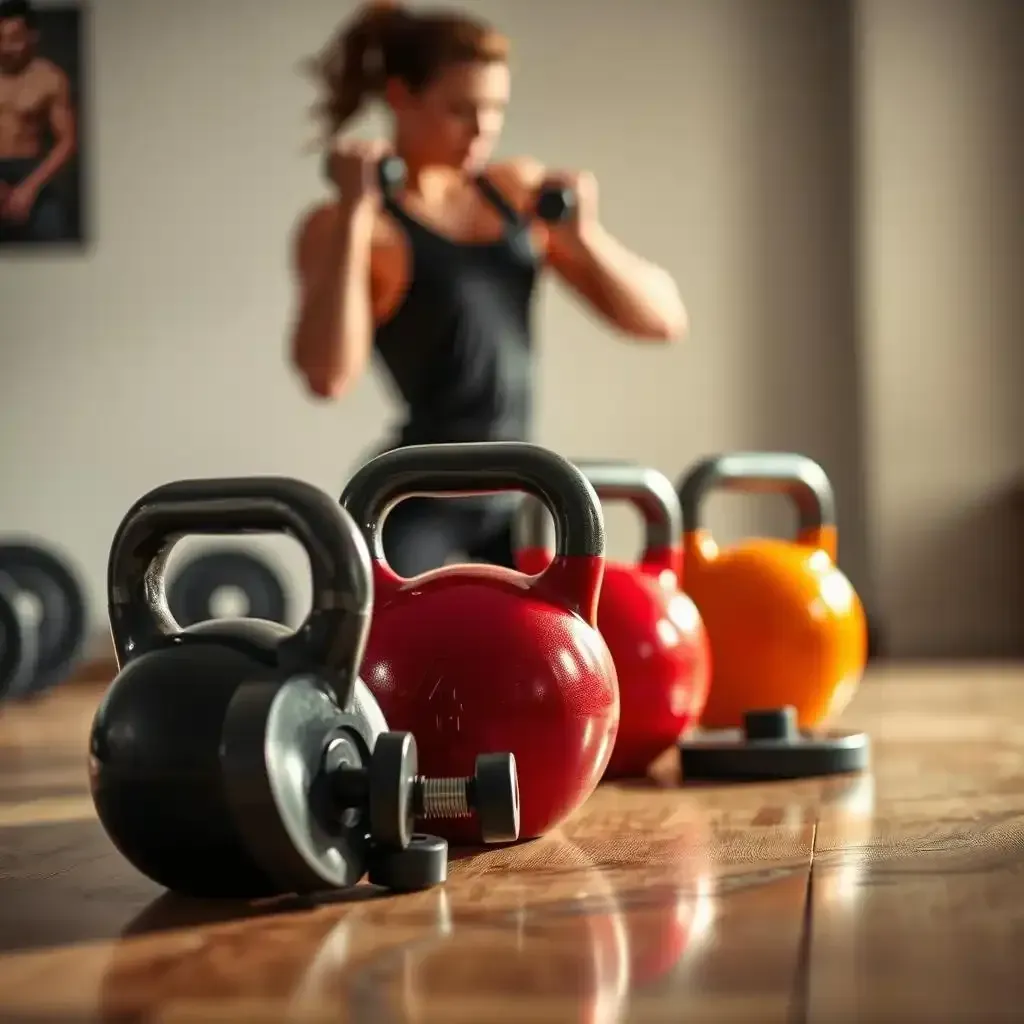Table of Contents
Are you intrigued by kettlebells but intimidated by the idea of complex workouts? Don't be! kettlebell exercises for ease are surprisingly accessible, even for complete beginners. This article will guide you through simple yet effective kettlebell moves that build strength, improve endurance, and leave you feeling empowered. We'll cover beginner-friendly exercises, proper form, and how to gradually increase the challenge. Forget the complicated routines; we're focusing on building a solid foundation. Remember, consistency is key! So grab your kettlebell (start light!), and let’s start on this fitness process together. Find more great kettlebell workouts and resources at kettlebellworkout.homes.
Kettlebell Exercises for Ease: Beginner-Friendly Moves
Hey there, fellow kettlebell enthusiast! So you're diving into the world of kettlebell exercises, huh? Awesome! Let's make it easy and fun. Forget those super-intense workouts you see online – we're building a solid base here. Think of it like learning to ride a bike: you wouldn't start with a downhill mountain race, right? You'd start with the basics and gradually build up your skills. Same goes for kettlebells!
One of the simplest and most effective kettlebell exercises is the kettlebell swing. It's like a controlled pendulum – you hinge at your hips, swing the kettlebell between your legs, and then powerfully drive it up to chest height. It's surprisingly full-body, working your legs, glutes, and back. Don't worry about getting it perfect right away; focus on good form and gradually increasing the weight. Check out this guide for more on kettlebell swings: Kettlebell basics.
- Start with a lightweight kettlebell.
- Focus on the hip hinge – don’t just use your arms.
- Keep your core tight and back straight.
Next up, the goblet squat. Hold the kettlebell close to your chest like a goblet (hence the name!). Then, squat down like you're sitting in a chair, keeping your back straight and chest up. This exercise is great for building leg strength and improving your balance. Remember to keep your chest up and your back straight while you squat. Want to learn more about proper form? This might help: Kettlebell form.
Exercise | Muscle Groups Worked | Tip |
|---|---|---|
Kettlebell Swing | Legs, Glutes, Back | Control the swing; don't just fling it! |
Goblet Squat | Legs, Glutes, Core | Keep your back straight; don't round your back. |
Another fantastic exercise for beginners is the kettlebell Turkish get-up. This might sound intimidating, but it's a surprisingly simple exercise that will help you build strength and stability. You start lying on your back with the kettlebell in one hand, and then you slowly get up into a standing position. It's a dynamic full-body exercise, and it’s great for improving your balance, coordination, and core stability. For more info and step-by-step guides, see our post on beginner routines: Beginner routines.
Remember, starting slow is key. Don't try to do too much too soon. Listen to your body. If something hurts, stop! And most importantly, have fun! Kettlebell training is a process, not a race. Think of these as your first steps on a path to a stronger, fitter you. Check out our tips for beginners: Kettlebell workout tips.
"The greatest of follies is to sacrifice health for any other kind of happiness." - Arthur Schopenhauer
Kettlebell Exercises for Ease: Building Strength and Endurance

Kettlebell Exercises For Ease Building Strength And Endurance
Okay, so we've nailed some basic kettlebell moves. Now let's talk about building some serious strength and endurance. Think of it like this: those beginner exercises were your warm-up laps; now it's time for the main event! We're not aiming for marathon running here, but building a solid foundation of strength that will help you tackle more advanced moves later. Remember consistency is key – even small, regular workouts are better than sporadic intense sessions. Check out some beginner-friendly routines here: Beginner routines.
One fantastic exercise for building both strength and endurance is the kettlebell swing. Yes, we talked about it before, but it’s so versatile! By increasing the weight gradually and doing sets of 10-15 swings, you’ll feel a burn in your glutes and back. And because it’s a full-body movement, you’re getting a cardio workout too. Don't just think of it as an arm exercise; it's way more than that! Want to level up your swings? Check out these tips: Kettlebell exercises.
- Start with a weight you can easily handle for 10-15 reps.
- Focus on proper form to avoid injury – check out our form guide!
- Gradually increase weight as you get stronger.
Another great choice is the goblet squat. It’s deceptively simple, but it builds incredible leg strength and core stability. Try holding the kettlebell for longer periods to build endurance. Think of how your legs feel after a long hike – that’s the kind of strength and endurance we’re after. This is a great exercise to start with because it's straightforward and builds a strong foundation. Check out more info on this exercise: .
Exercise | Strength Focus | Endurance Focus |
|---|---|---|
Kettlebell Swing | Increase weight gradually | Sets of 15-20 reps |
Goblet Squat | Hold heavier weight | Longer hold times, more reps |
Now, don't forget the importance of rest! Your muscles need time to recover and rebuild. Think of your muscles like a sponge: they absorb the work you put in, but then they need time to soak up the water (rest) and replenish. Pushing too hard too often can lead to injury and burnout – no fun! Check out these simple recovery tips for better results: Easy kettlebell exercises.
Let’s talk about that amazing feeling after a good workout. It's that satisfying mix of tiredness and accomplishment. That’s what we’re building towards – that feeling of strength and endurance. Remember to start small and celebrate your progress along the way. It’s a trip, not a race! This is all about building a habit, and that takes patience and consistency. For a great plan, see our guide on building a routine: Workout plan.
"The body achieves what the mind believes." - Napoleon Hill
Kettlebell Exercises for Ease: Mastering Proper Form and Technique

Kettlebell Exercises For Ease Mastering Proper Form And Technique
Why Proper Form Matters: It's Not Just About the Burn
Hey there, kettlebell newbie! I get it – you're excited to start seeing results, and who wouldn't be? But before you go all-out, let's talk about something super important: proper form. This isn't just some boring rule; it’s your secret weapon against injuries and your key to unlocking the *real* ability of kettlebells. Think of it like this: you wouldn't try to build a house without a strong foundation, right? Proper form is your kettlebell foundation. Mastering it means you'll get stronger faster, feel better, and avoid those pesky aches and pains. Need a refresher on the basics? Check out our guide on to get started.
- Start light. Seriously, lighter than you think!
- Focus on slow, controlled movements. Speed comes later.
- Engage your core! It's your powerhouse.
Making it Work for You: Adjustments and Modifications
Everyone's different, and that's awesome! What works for one person might not work for another. That's why it's so important to understand how to adjust your kettlebell exercises to fit your own body and experience level. Don't be afraid to modify exercises to make them easier. For example, if a full squat feels too challenging, try a half squat or even just a partial hip hinge. It's all about finding what feels good and what your body can handle. If you're struggling with a particular exercise, don't hesitate to look up videos or ask for advice from a qualified trainer. Remember, consistency is more important than intensity, especially when you're starting out. There's plenty of help available, so don't be shy! Check out these technique tips for more detailed information.
Exercise | Modification for Beginners | Focus |
|---|---|---|
Kettlebell Swing | Shorten the swing arc | Hip hinge and core engagement |
Goblet Squat | Use a chair for support | Controlled descent and ascent |
"The difference between ordinary and extraordinary is that little extra." - Jimmy Johnson
Kettlebell Exercises for Ease: Scaling Your Workout for Progress

Kettlebell Exercises For Ease Scaling Your Workout For Progress
Listen to Your Body: It's Not a Competition
Hey there, kettlebell friend! So you've been swinging and squatting, feeling stronger every day. That's awesome! But remember, this isn't a race. It's a process. Think of it like climbing a mountain – you wouldn't sprint to the top, would you? You'd take it one step at a time, finding your rhythm and enjoying the view. Similarly, with kettlebells, progress is about consistency, not intensity. If you're feeling sore, rest! Don't push yourself too hard, too fast. Your body will thank you for it. And remember, even small improvements count! We're building a foundation of strength and endurance that will last a lifetime. Need some ideas on how to structure your workouts? Check out our for inspiration.
- Don't compare yourself to others.
- Celebrate small wins – every rep counts!
- Rest and recovery are crucial.
Smart Progression: Leveling Up Your Kettlebell Game
Okay, so you're feeling confident with the basics. Fantastic! Now it's time to think about how to make your workouts more challenging. One of the easiest ways is to increase the weight of your kettlebell. But don't jump to a heavier weight too quickly! Start by adding just a little bit more weight – maybe 2-5 pounds – and see how it feels. If it feels too heavy, go back to the lighter weight. Another way to progress is by increasing the number of repetitions or sets you do. Or you can try adding more challenging variations of the exercises you already know. For example, instead of a regular goblet squat, you could try a pistol squat (if your balance is good!). Remember, small, gradual increases are the key to consistent progress. And remember, proper form is always more important than heavier weights. You can always find more routines and exercises on our website! Check out our kettlebell workouts for ideas.
Progression Method | How to Implement | Important Note |
|---|---|---|
Increase Weight | Add 2-5 pounds at a time | Prioritize proper form. |
Increase Reps/Sets | Add 1-2 reps or 1 set per week | Listen to your body; don't overdo it. |
"Progress is not a straight line; it's a process with its ups and downs." - Unknown
Final Thought
Starting your kettlebell process with ease is about finding what works for you. Remember to listen to your body, prioritize proper form, and celebrate your progress. Don’t rush the process; building strength takes time and dedication. With consistent effort and the right approach, you'll soon learn the strength and versatility of kettlebell training, transforming your fitness goals into reality. Keep exploring different kettlebell exercises, and remember to always consult a healthcare professional before starting any new workout routine. Happy lifting!